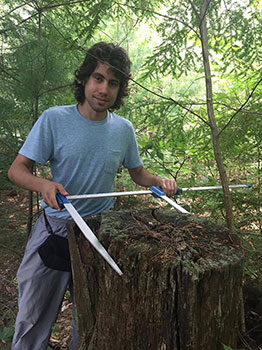You are here
Everyone’s trying to avoid ticks here this summer, I’m trying to find them
 When most people think of infectious diseases they think of the common cold, the flu, diseases that we give to each other. Some of the world’s worst outbreaks, however, happened when people moved into uninhabited places or made changes to those local habitats. This summer I have been researching how the makeup of a forest after it has been harvested for trees is related to the risk of exposure of disease, specifically Lyme’s disease.
When most people think of infectious diseases they think of the common cold, the flu, diseases that we give to each other. Some of the world’s worst outbreaks, however, happened when people moved into uninhabited places or made changes to those local habitats. This summer I have been researching how the makeup of a forest after it has been harvested for trees is related to the risk of exposure of disease, specifically Lyme’s disease.
Between my mentors, my peers, and myself, we are collecting enormous amounts of data on the forest structure for a post-harvest carbon dynamics and forest biodiversity study. Everything from a tree’s diameter at breast height to the number of seedlings to the species identification of plants within our 20-meter by 20-meter plots is recorded. The question we are asking is if carbon is returning after harvest and the larger question is how sustainable the resource management is, but I wanted to add an extra dimension to the concept of sustainability.  I wanted to find out if the post-harvest forest biodiversity has effects on people and in turn, redefine sustainable resource management practices to incorporate sustainable disease prevention. A forest may be growing back after harvest, but it is worth asking what kinds of ecological changes and interactions happen between harvest periods that could affect people.
I wanted to find out if the post-harvest forest biodiversity has effects on people and in turn, redefine sustainable resource management practices to incorporate sustainable disease prevention. A forest may be growing back after harvest, but it is worth asking what kinds of ecological changes and interactions happen between harvest periods that could affect people.
Strolling through Harvard Forest, it didn’t take long for me to notice that there were a couple forest species I consistently interacted with, Ixodes scapularis and Dermacentor variabilis or more commonly known as deer ticks and dog ticks. The northeastern region of the U.S. is the epicenter of tick-borne illnesses and with Lyme’s disease as the most popular diagnosed of these illnesses, it seemed like a natural transition to make this disease a focus of my research. I could easily walk through the forest and find one of the bloodsuckers on me if I stayed still for long enough, but I had to be more scientific in how I went about collecting them. Through my mentors, I had the opportunity to tick sample with the National Ecological Observatory Network (NEON) and a few trips to Walmart later I had the supplies I needed to tick sample myself. Using a 1-meter by 1-meter white flannel cloth, a wooden pole, and string, with the help of the Harvard Forest woods crew I constructed a high-tech state of the art device that attracted even more ticks to me than I ever thought before - a tick cloth. Dragging this cloth along the perimeter of our plots, ticks effortlessly clung onto the fabric and fell victim to forceps and an ethanol death chamber. A small vial filled with about 5 milliliters of ethanol was the last fluid these ticks would ever meet with before becoming specimens in my collection.
 I have yet to finish tick sampling but with luck, I hope to present some interesting findings on the relationship between forest structure and presence of Lyme’s disease by the end of this summer. Aside from all the research skills and experiences I have gained from the REU, I have had fun going on trips to witch towns and ivy league campuses, playing Pictionary games and losing my voice in karaoke sessions. There is so much more I would like to say about the summer REU experience, and I am severely understating the collaboration of my peers and mentors in this short blog post. As the summer here nears its end, I anticipate a bittersweet farewell between everyone making this experience possible. Still, with optimism, I look forward to exploring where my research will take me as I enter my senior year as an undergraduate student.
I have yet to finish tick sampling but with luck, I hope to present some interesting findings on the relationship between forest structure and presence of Lyme’s disease by the end of this summer. Aside from all the research skills and experiences I have gained from the REU, I have had fun going on trips to witch towns and ivy league campuses, playing Pictionary games and losing my voice in karaoke sessions. There is so much more I would like to say about the summer REU experience, and I am severely understating the collaboration of my peers and mentors in this short blog post. As the summer here nears its end, I anticipate a bittersweet farewell between everyone making this experience possible. Still, with optimism, I look forward to exploring where my research will take me as I enter my senior year as an undergraduate student.
There are very few things that make the experience at Harvard Forest unpleasant, ticks being one of them. But, if ticks are what make my summer project exciting, doesn’t that go to show you just how great this entire experience has been to me?
Aaron Aguila is a rising senior at the University of Florida studying Wildlife Ecology and Conservation

